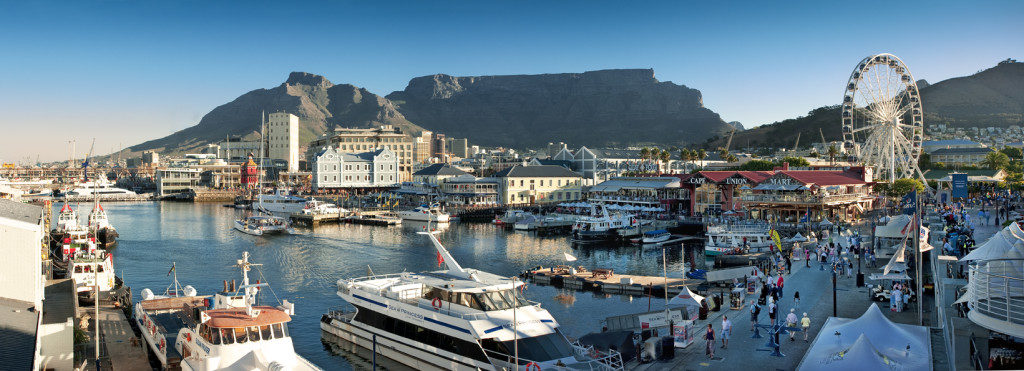
There are places in the world that let you know immediately how closely we’re connected and Cape Town is one of them. Seventeen hours by air from the United States, three-quarters of an entire day, it is on the surface very much like what a large American city looks like with its solid infrastructure and its thriving tourism economy. Even within the throes of a dire drought, the city continues to bustle with little evidence of its desperate prospects.
Most city dwellers love urban life and they often look for its pleasures when they travel. People from around the world flock to Cape Town during the region’s summer months of November through February. Every day during peak season, 180,000 of them of them end up at the Victoria and Albert Waterfront, a sprawling playground of shops and restaurants that lacks the gaucheness of San Francisco’s Fisherman’s Wharf and exudes a carefree open air European chic. Wonderfully talented musicians like the Ilitha Lelanga Marimba Ensemble and exotic mimes compete to enthrall out of towners with the electric pulse of their sound or the eerie realism of the motionless characters they’re impersonating.

Walking distance from downtown, the Waterfront is just as popular with locals; much in the way Chicago’s Navy Pier remains an irresistible siren to its residents. It’s also where you’ll see the kind of cavalcade of faces that you won’t experience anywhere else on the globe. A place where worlds meet and a place that shows first-hand what humanity looks like when opposite worlds blend. Some of the most engrossing of them all are the native faces that carry the unmistakable look of place. Whether they are Zulu, Dinka, Sotho or another of the many tribes of South Africa, their features are distinct and beguiling.

The gastronomic side of the Waterfront features seafood and fast casual predominantly with a good representation of Italian cuisine. Not only are most restaurants geared to western tastes; most of them can be considered good to very good.

Venturing into the core of the city, a different profile emerges as people wait in queues for buses or walk purposefully along the streets. Here the diversity in faces virtually disappears and the harsher economics of the city come into sharper focus. The architecture of colonialism emerges along with the vestiges of South Africa’s apartheid past. It’s here you begin to see the city’s and the country’s complexity and glimpse some of the challenges that they face.

Some of those challenges stem from one of the city’s most popular tourist attractions: Robben Island. Approximately 20 minutes by ferry from the glistening retail pomp of the Albert and Victoria Waterfront, the island has been in use since the 17th century. Formerly a leper colony, Robben Island’s true notoriety comes from its use as a maximum-security political prison during the Apartheid period that began in the late 40’s and ended in 1990. Nelson Mandela, it’s most famous inhabitant, eventually rose to become the country’s president after 27 years of incarceration. Now ex-prisoners are docents, giving first person accounts of the types of lives they lived on the island.
Remote and stark, the island carries with it a sense of suspension; like some heinous memorialized purgatory. Walking the grounds, peering into the cells and listening to the guide’s accounts of daily life at the prison, you can also faintly discern the spirit and spirits of the facility. Not only the did the degradation perpetrated at the prison feel tangible, but reliance and strength the prisoners provided each other also become clear through the guide’s narrative. South Africa’s current political struggles leave the impression that Robben Island is as much tied to South Africa’s present as it is to its past.

With a towering 3500’ natural wall at its back, Cape Town also has natural beauty standing right at his shoulder. Table Mountain, with its two-mile-wide plateau at the very top is easily Cape Town’s most photographed attraction. More correctly, the views of Cape Town from the mountain’s summit rack up the most snaps. Although there are many who choose to climb the mountain to the plateau, the preferred mode of transport is a gentle cable car in continuous rotation from the foot of the mountain to its flat top. Crowds can get intense. Planning your visit to avoid peak attendance is highly recommended. If you find yourself in a two-hour queue for a descending cable car, you might question whether the captivating views were worth it. They are. But if you have an option to make the visit less tedious, maximize the quality of time you spend in Cape Town and do your homework on this one.

Next: Into the bush on an African Photographic Safari –